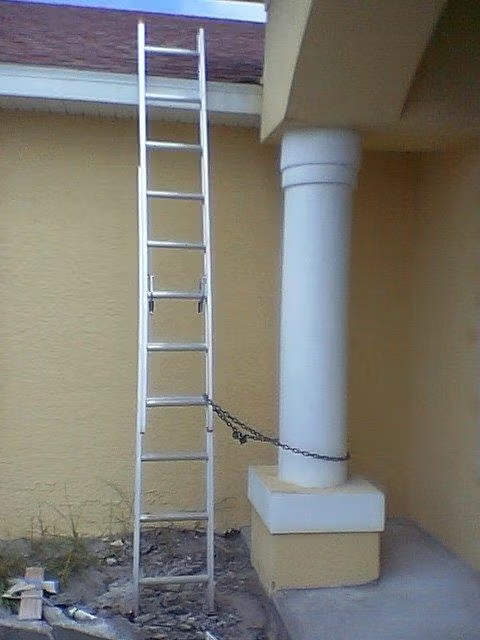
Center for Problem-Oriented Policing
Responses to the Problem of Burglary at Single-Family House Construction Sites
Analyzing your local problem will give you a better understanding of the factors that contribute to it. Once you have analyzed your local problem and established a baseline for measuring effectiveness, you can consider possible responses to the problem.
The following responses will provide a foundation for addressing your particular burglary problem. These strategies are drawn from research studies and police practice and are generally based on opportunity blocking. It is critical that you tailor responses to local circumstances and that you can justify each response based upon reliable analysis. Several of these strategies may apply to your local problem; and in fact, an effective remedial strategy will likely involve the implementation of several different responses.
Because law enforcement alone is seldom effective in reducing or solving the problem, do not limit yourself to considering only what police can do; rather, carefully consider whether others in your community share responsibility for the problem and whether they can help respond to it. In some cases, responsibilities may need to be shifted toward those who have the capacity to implement more effective responses. (For more detailed information on shifting and sharing responsibility, see Response Guide No. 3, Shifting and Sharing Responsibility for Public Safety Problems). Building partnerships and working towards a collective response with the various stakeholders is essential to success.§ This is particularly true in regard to construction site burglaries, because so many of the factors that contribute to the problem are related to building practices.
§ See Problem-Solving Tools Guide No. 5 on Partnering With Businesses to Address Public Safety Problems.
General Considerations for an Effective Response Strategy
There is little research evaluating responses to the problem of construction site burglaries. Therefore, the responses discussed below emphasize appropriate and practical opportunity blocking. Blocking criminal opportunities often has a greater direct effect on offenders than do other crime prevention strategies.[26]
Police should establish cooperative working relationships with builders. In turn, builders should share information about burglary problems and patterns, local building practices, and loss prevention efforts. Builders should be encouraged to provide police with after-hour contact numbers, documentation of stolen appliances, and tool serial numbers.
If it can be established that certain houses are at a high risk for victimization, response measures can be concentrated at those locations. For example, the Port St. Lucie (Florida) Police Department determined that houses in the final stages of construction were at a higher risk of burglary and used this information to target police attention.[27]
Specific Responses to Reduce Burglary at Single-Family House Construction Sites
Improving Builder Practices
1. Limiting the number of construction sites supervised. In order to provide meaningful supervision of construction sites, builders should limit the number of sites for which each supervisor is responsible. This will allow supervisors a better opportunity to monitor materials, workers, and deliveries. In an example of such a program, the Port St. Lucie (Florida) Police Department convinced a builder to reduce each supervisor's responsibility from 30 to 35 houses to 15 to 20 houses.[28]
2. Coordinating delivery and installation. Coordinating deliveries of materials and appliances so that they are delivered and installed close to the time that the items will be secured or the house will be occupied can reduce their exposure to theft. Materials left unattended or unsecured for long periods of time can entice both opportunistic burglars and construction workers. Builders should install expensive high risk items as close to the end of construction as possible; in some cases it may even be possible to install the items after the house is occupied. A project in Charlotte, North Carolina focused on delaying the installation of plug-in appliances until immediately prior to or just after occupancy.[29]
Examples of poor coordination of deliveries include:
- framework and roof trusses being delivered before the slab has been laid
- windows being delivered before the roof has been installed
- bricks being delivered before the frame stage has been started
- dishwashers, ranges, refrigerators, and other appliances being delivered before locking doors and windows are installed.
3. Screening and training workers and subcontractors. Whenever possible, builders should screen prospective employees and subcontractors, including both criminal and financial background checks. Builders should clarify, emphasize, and enforce rules that prohibit the taking of construction tools, materials, and property that have been delivered for use onsite. Workers should be taught to recognize and report suspicious activity and signs of burglary and reminded of crime prevention measures that they themselves can take.
4. Limiting the hiring of subcontractors. Builders should be encouraged to maintain a consistent workforce that is familiar with their rules, practices, and attitudes toward misappropriation of property. Builders who use subcontractors who in turn hire other subcontractors are likely to be at a higher risk of being burglarized.
5. Having a system for tracking tools. There are various tool tracking systems that can be used to limit opportunities for burglary. Some builders designate one person to track the use of tools, which can help instill a sense of accountability in workers and reinforce the perception that management is watching over inventory. Others builders, like Celebrity Homes in Omaha, Nebraska, fit their tools with microchips. The site foreman scans the tools before they are issued, recording information such as the date, time, and the name of the worker to whom the tool is issued; the foreman then scans the tools again when they are returned.[30] § Yet other builders provide each site supervisor with a budget for tools and hold the supervisor to account—through bonuses or penalties—at the completion of the job.[31]
§ The microchip tags used by Celebrity Houses were supplied by tool maker Bosch, whose Safe and Sound tool tracking system is an alternative to the common practice of engraving or marking (O'Malley, 2005).
6. Encouraging the hiring of loss prevention personnel. Large builders especially should be encouraged to retain the services of professional loss prevention specialists who have expertise in preventing and solving burglaries and who can work closely with police and other builders to control burglary.
8. Establishing an employee hotline to report crime. Many individual builders and builder associations have established hotlines that allow callers to report crime anonymously. Callers can receive cash awards if the information leads to an arrest.[34] Employee hotlines have not been systematically evaluated; however, recent research indicates that employees are less likely to steal when they believe there is a high probability of apprehension. The study found that the threat of being punished by coworkers had a greater deterrent effect than did the threat of punishment by management.[35] Thus, it is reasonable to believe that hotlines have the potential to increase an offender's perception of apprehension if other tradespeople have a mechanism to report them and are encouraged to do so.
Some companies have found that hotlines are a cost effective way to control theft.[36] In Northern California, a hotline system that rewards individuals up to $1,000 is funded through membership dues, association contributions, and a grant. In 2003, the system paid out $8,000 in rewards and recovered over $2 million in stolen property.[37] §
§ A survey conducted of ten large U.S. retail companies, which represented almost 50 percent of U.S. stores, found that a hotline with some sort of rewards (for example, cash) was effective in convincing employees to report theft. The survey indicated that successful programs create a supportive environment in which reporting mechanisms and participation incentives are sufficient to encourage employees to report theft or other inappropriate behavior by their coworkers (Scicchitano, Johns, and Blackwood, 2004). See Scicchitano, Johns, and Blackwood (2004) for a summary of the use of toll-free hotlines for reporting dishonesty, techniques for encouraging the use of the hotlines, and recommendations for companies that want to implement hotlines.
9. Adopting and enforcing antitheft policies. Construction site workers who are tempted to steal are likely to be deterred by the threat of being fired. Offenders who are convicted of construction site crime should be fired and restricted from obtaining other positions in the industry. This message should be consistently reinforced: for example, contractors can require newly hired employees to sign a no-stealing contract; builders can speak out publicly on these issues at meetings or in the media; workers can be reminded of specific policies through company newsletters or via signs posted at the construction sites; and so forth.
Target Hardening
10. Improving lighting at construction sites. Proper lighting can deter burglars both by illuminating security measures in place at the construction site and by increasing the ability of passersby and police to observe suspicious activity at the site. A systematic review of the effects of improved street lighting on reducing crime indicated some promise. Although an evaluation of 13 studies from the United States and Great Britain had mixed results—some studies indicated a reduction while others did not—an analysis of all 13 studies showed an overall 20 percent reduction in the crime rate.[38]
The Casey city council in Victoria, Australia initiated a policy that mandated street lighting for construction areas. Prior to the initiative, street lighting was activated when the first occupants moved in, which meant that there was no street lighting during construction in unoccupied areas. The new policy authorized the activation of street lights at the time of the release of each subdivision.[39]

Credit: Rachel Boba and Roberto Santos
11. Installing and monitoring closed circuit television. Closed circuit television (CCTV) has been shown to be effective in deterring property crime. Evaluations of CCTV reveal that it is effective where an adequate number of cameras cover a particular area as well as on sites with limited and controlled access points.[40] § In order to provide such coverage, portable towers equipped with cameras can be placed at strategic site locations.[41]
§ See Response Guide No. 4 on Video Surveillance of Public Places.
12. Installing alarm systems. Alarm systems can be a cost-effective deterrent in high risk areas. There are a number of different alarms available, including wireless systems that can be adapted to the environment (for example, for use in onsite storage containers). Some wireless alarms can be installed at any stage of the construction, without the need for pre-wiring or other electrical work.[42] Signs indicating that alarms are in use should be prominently displayed to reinforce the deterrent effect. However, care should be taken to ensure that false alarms do not drain police resources.§§
§§ See Problem-Specific Guide No. 5 on False Burglar Alarms.
13. Using portable storage units. Properly secured storage units should be used for materials that are kept at construction sites overnight. These units should be equipped with wireless audible alarms and locks that prevent the use of bolt cutters.
15. Marking property. Marking property with identification helps control burglary in three ways: it warns burglars that owners are monitoring their property, it discourages potential buyers of stolen property, and it increases the probability that recovered property will be returned to its rightful owner. However, property marking efforts have had mixed results. Property marking appears to be most effective when extensive efforts to enlist participation and cooperation are combined with a media campaign warning burglars that marking will reduce the property's value and make disposal difficult.[43] Ideally, all portable building materials, including doors, windows, bricks, and tiles, should be marked at the point of manufacture with specific builder or construction site identification. The markings from each construction site should then be recorded. Signs should be prominently posted on the construction site indicating that items have been marked.
16. Installing global positioning satellite locator chips. Global positioning satellite (GPS) locator chips can be used to track and recover high-end appliances and equipment. If the property is stolen, the chip allows the builder or the police to monitor its movement by computer. This is most useful for high risk property when a specific crime pattern has been identified or when information has been received from a confidential informant.

on major appliances to increase the
perception of risk of being caught.
Credit: Port St. Lucie(FL) Police Department
17. Displaying crime prevention signage. Prominently and strategically displayed signage can inform potential burglars that builders and police are working to reduce theft from construction sites. Well-designed, sturdy signs that can easily be modified and used at different sites can be a cost-effective prevention measure.[44]
Police Responses
18. Enhancing natural surveillance. Once a construction site burglary problem has been identified, police can contact residents, builders, and other groups and individuals likely to be in the area and request their assistance in reporting suspicious behavior. "Reverse 911 systems," including those that use autodialers, can be used to communicate efficiently with a large but targeted population.
19. Making use of publicity.§ Many police agencies and other groups have developed publicity campaigns aimed at combating construction site crime. These campaigns publicize crime detection and prevention efforts in a variety of ways: through newspaper articles designed to increase community awareness and to remind residents to be on the look out for suspicious behavior; through brochures detailing the nature of the problem and delineating crime prevention tips; and through informational letters to builders and homeowners in high risk areas.[45] In addition, local mass media programs such as Crime Stoppers can be useful for soliciting tips about construction site burglaries. Publicizing the arrest of burglars can also enhance general deterrence and discourage builders from hiring these individuals. Police should consult local legal counsel about the proper wording of such notices.
§ See Response Guide No. 5 on Crime Prevention Publicity Campaigns.
20. Disrupting stolen goods markets. Although there is little research on its effectiveness, requiring pawnshops to keep adequate records of the goods they purchase is regarded as a sensible measure geared toward disrupting stolen goods markets.[46] In many jurisdictions, the recording of such information and its transmission to police has been automated. Strategies for disrupting the sale of stolen goods include conducting surveillance of stores suspected of dealing in stolen property, encouraging stores that buy used property to display signs stating that they are part of a program designed to prevent the sale of stolen goods, and enacting ordinances that require stores to establish the ownership of used goods before they are purchased.

Credit: Fort Pierce (Florida) Tribune, September 2005
Responses With Limited Effectiveness
21. Police patrolling of construction sites. Research suggests that preventative police patrolling is an ineffective measure for dealing with the problem of construction site burglary.[47] Because of the large number of potential targets, general police patrols of construction sites are unlikely to deter crime or apprehend offenders. Focused patrols of particular subdivisions or of houses that are at vulnerable stages of construction may be a more useful response.
23. Conducting fencing "sting" operations. Sting operations, in which police set up bogus fencing operations, are both expensive and time-consuming. In addition, research suggests that they often generate more crime than they prevent.[48] §
24. Increasing penalties for burglars. The chance of a residential burglar getting caught and sentenced is about 5 percent; for construction site burglars the percentage can be even lower. One study suggests that increased penalties alone do not deter burglars from offending; rather, increased penalties deter offenders only if they are combined with an increased perception of risks or a decreased anticipation of reward.[49]
Free Bound Copies of the Problem Guides
You may order free bound copies in any of three ways:
Online: Department of Justice COPS Response Center
Email: [email protected]
Phone: 800-421-6770 or 202-307-1480
Allow several days for delivery.
Email sent. Thank you.
Burglary at Single-Family House Construction Sites
Send an e-mail with a link to this guide.
* required
Error sending email. Please review your enteries below.
To *
Separate multiple addresses with commas (,)
- Your Name *
Your E-mail *
Copy me
Note: (200 character limit; no HTML)
Please limit your note to 200 characters.